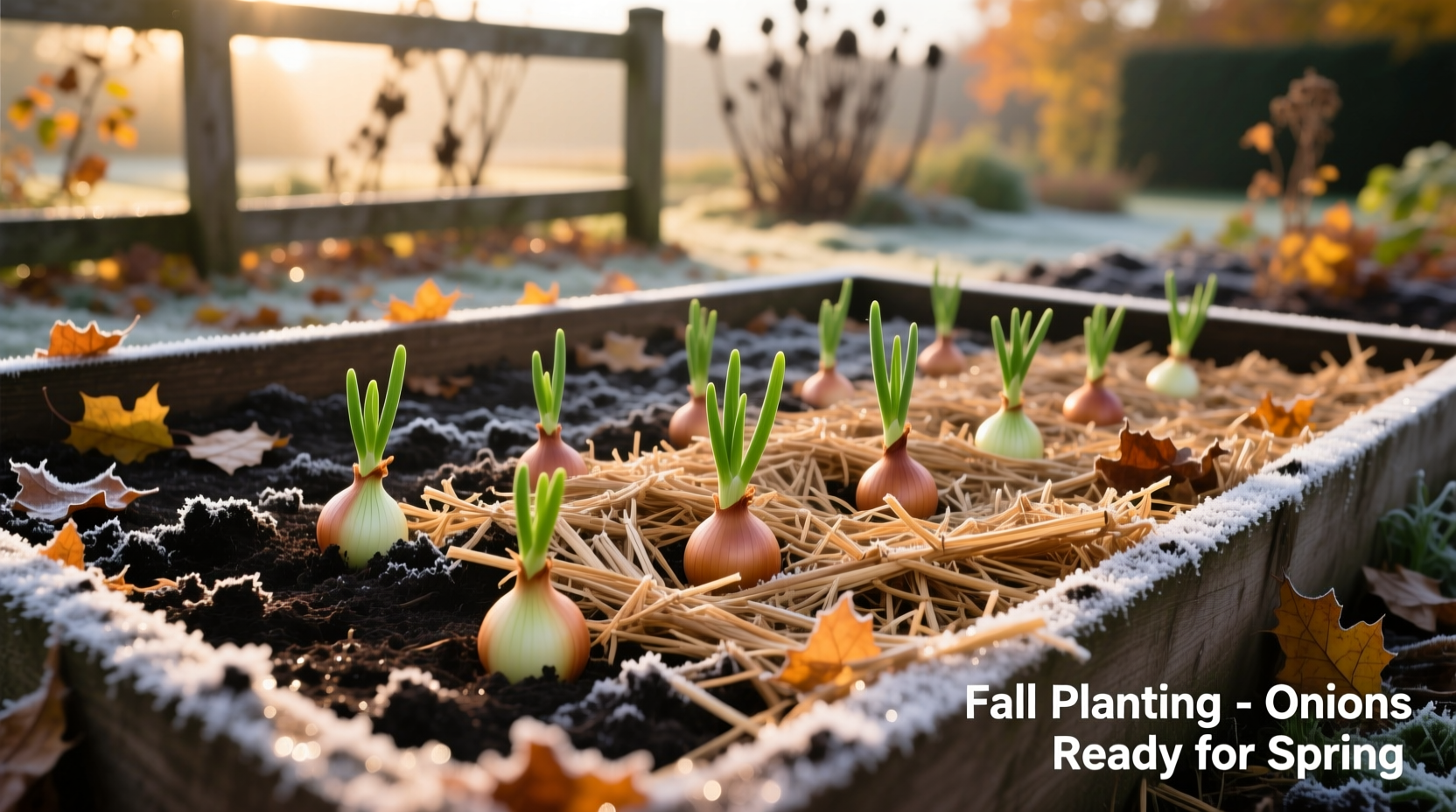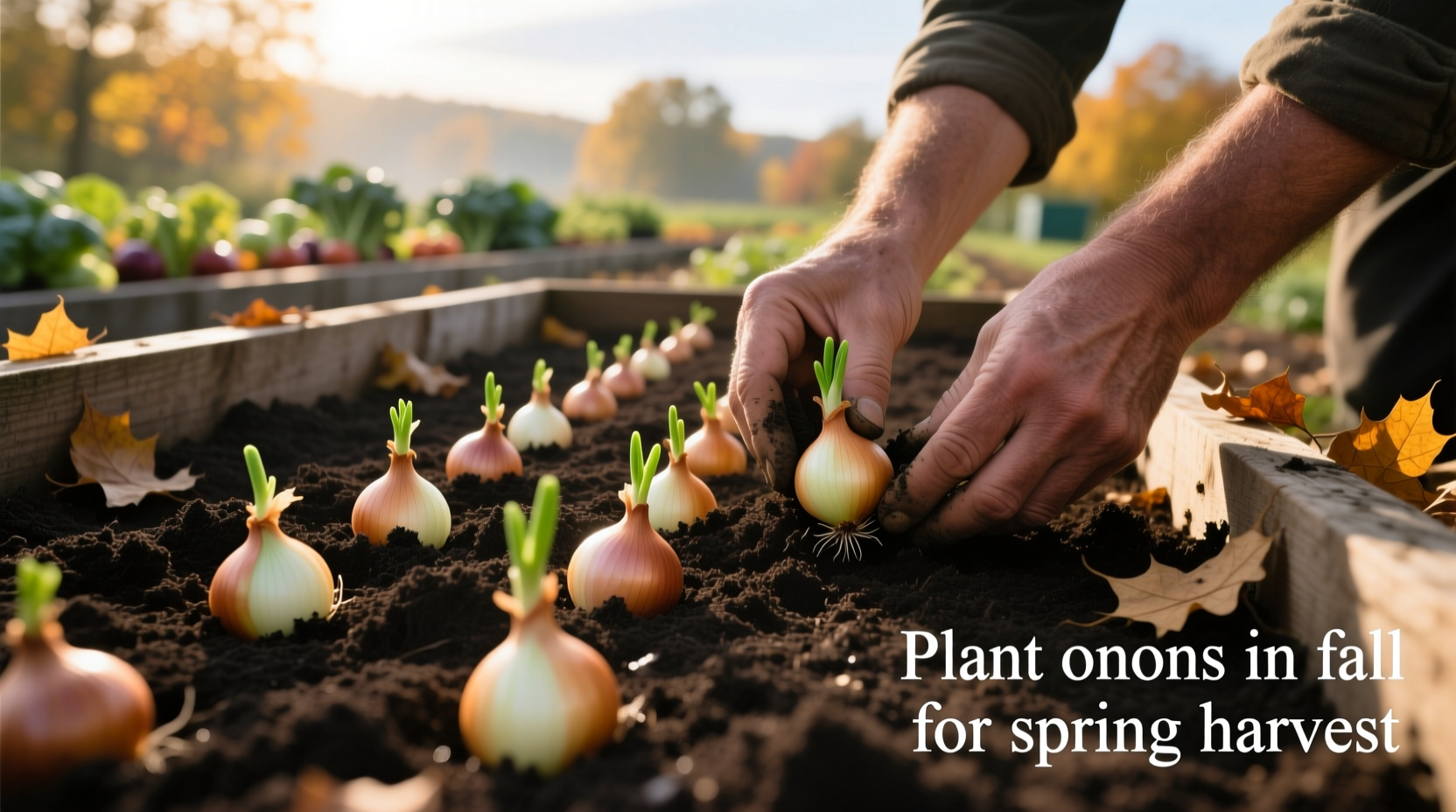Planting onion sets in the fall transforms your gardening calendar, delivering harvests up to four weeks earlier than spring-planted crops while reducing common issues like bolting. This strategic timing leverages natural seasonal cycles to produce onions with superior size, flavor, and storage potential. Whether you're managing a small backyard plot or planning for market production, fall planting offers distinct advantages that can significantly improve your onion yields.
Why Fall Planting Outperforms Spring for Onions
Fall-planted onion sets develop stronger root systems before winter dormancy, creating what agricultural researchers call "overwintering advantage." According to Cornell University's horticulture department, onions that establish roots in fall typically produce 25-30% larger bulbs than their spring-planted counterparts. The extended growing season allows plants to develop more leaf area before bulb formation begins, directly translating to larger harvests.
The natural cold period also reduces bolting risk—the premature flowering that ruins bulb development. Onion sets planted in fall experience the necessary vernalization (cold exposure) during winter, preventing the temperature fluctuations in spring that often trigger bolting in spring-planted crops.
| Planting Method | Harvest Time | Average Bulb Size | Bolting Risk | Storage Duration |
|---|---|---|---|---|
| Fall Planting | Early-Mid Summer | 25-30% larger | Low (10-15%) | 6-8 months |
| Spring Planting | Late Summer | Standard | High (30-40%) | 4-6 months |
Best Onion Varieties for Fall Planting
Not all onion varieties succeed with fall planting. Short-day and intermediate-day varieties work best for fall planting in most climates. These types begin bulb formation when daylight reaches 10-14 hours, perfectly aligning with spring conditions after winter dormancy.
Recommended varieties include:
- Red Baron - Excellent for colder zones, stores well
- Electric - Deep purple, sweet flavor, good storage
- Stuttgarter - Reliable performer, mild flavor
- Walla Walla - Sweet variety, best in milder climates
Avoid long-day varieties for fall planting unless you live in northern regions above USDA zone 5. These require 14+ hours of daylight to form bulbs and won't mature properly when planted in fall in southern regions.

Fall Planting Timeline: When to Plant Onion Sets
Timing is critical for successful fall onion planting. Plant too early and sets may sprout prematurely before winter; plant too late and roots won't establish sufficiently before ground freezes. The ideal planting window occurs 4-6 weeks before your first expected frost date.
USDA agricultural research shows optimal root development occurs when soil temperatures remain between 50-65°F (10-18°C) for at least 30 days after planting. This allows sufficient root establishment without significant top growth that would be vulnerable to winter damage.
Use this planting timeline as your guide:
- USDA Zones 3-4: August 15-September 1 (Northern Midwest, Canada)
- USDA Zones 5-6: September 1-15 (Midwest, Northeast)
- USDA Zones 7-8: September 15-October 15 (Southeast, Pacific Northwest)
- USDA Zones 9-10: October 15-November 15 (Southern states, California)
Step-by-Step Fall Planting Guide
Follow these professional techniques for successful fall onion planting:
Soil Preparation (2 Weeks Before Planting)
Prepare your soil properly to ensure optimal growth. Onion sets prefer well-draining soil with pH between 6.0-6.8. Amend heavy clay soils with 3-4 inches of compost and coarse sand. For sandy soils, add 2-3 inches of compost to improve moisture retention. Avoid fresh manure, which can cause excessive top growth at the expense of bulb development.
Planting Technique
Planting depth and spacing directly impact bulb development:
- Separate sets by size (smaller sets produce better bulbs)
- Plant with pointed end up, 1-2 inches deep
- Space 4-6 inches apart in rows 12-18 inches apart
- Cover with soil and water thoroughly
Winter Protection Essentials
Proper winter protection determines whether your fall-planted onions survive to harvest. Apply 3-4 inches of organic mulch (straw, shredded leaves, or pine needles) after the ground cools but before it freezes. This maintains consistent soil temperature, preventing the freeze-thaw cycles that heave plants from the soil.
In regions with severe winters (USDA zones 3-5), consider using row covers over the mulch for additional protection. University of Minnesota extension research shows this combination reduces winter kill by up to 75% compared to unprotected plantings.
Common Challenges and Solutions
Fall-planted onions face specific challenges that require proactive management:
Frost Heaving
Freeze-thaw cycles can push plants from the soil. Prevent this by ensuring proper mulching and avoiding planting in poorly draining areas. If heaving occurs, gently press plants back into soil and add additional mulch.
Pest Management
Thrips and onion maggots pose threats to fall-planted onions. Prevent maggot damage by rotating planting locations annually and using floating row covers. For thrips, apply neem oil early in the growing season before populations establish.
Excessive Fall Growth
If warm weather persists after planting, onions may produce excessive top growth vulnerable to winter damage. If tops exceed 6 inches before hard frost, trim to 4 inches to reduce wind damage and moisture loss.
Spring Care and Harvest Timeline
As winter ends, your care approach shifts to support vigorous growth:
- Early Spring: Remove mulch gradually as temperatures warm
- March-April: Apply balanced fertilizer as growth resumes
- May: Reduce watering as bulbs begin to swell
- June-July: Harvest when tops fall over naturally
Fall-planted onions typically mature 2-4 weeks earlier than spring-planted crops. Watch for the characteristic top-fall that signals harvest readiness. Cure onions thoroughly before storage to maximize shelf life.
Frequently Asked Questions
Can I plant onion sets in fall in cold climates?
Yes, fall planting works in cold climates (USDA zones 3-5) with proper winter protection. Plant 4-6 weeks before first frost, apply 4 inches of mulch after soil cools, and consider adding row covers for extreme cold. Research from the University of Vermont shows properly protected fall-planted onions survive temperatures as low as -20°F (-29°C).
How deep should I plant onion sets in fall?
Plant onion sets 1-2 inches deep with the pointed end up. Shallow planting (1 inch) works better in heavy soils, while slightly deeper planting (2 inches) suits sandy soils. Proper depth prevents premature sprouting in fall while allowing easy emergence in spring. Planting too deep can delay growth, while too shallow risks exposure to winter temperature fluctuations.
What's the difference between planting onion seeds and sets in fall?
Onion sets (small pre-grown bulbs) establish more quickly than seeds in fall planting. Sets develop sufficient root systems in 4-6 weeks, while seeds require 8-10 weeks—often too long before winter. Sets also have lower bolting risk and produce more uniform bulbs. However, seed-grown onions typically store longer. For fall planting, sets provide more reliable results for home gardeners.
How do I prevent my fall-planted onions from bolting?
Prevent bolting by selecting appropriate varieties (short-day or intermediate-day), planting at the correct fall timing (4-6 weeks before first frost), and avoiding excessive nitrogen fertilization. Bolting occurs when plants experience temperature fluctuations that mimic spring conditions. Proper mulching maintains consistent soil temperature, reducing this risk. Research from Oregon State University shows fall-planted onions have 60-70% lower bolting rates than spring-planted crops when managed correctly.











 浙公网安备
33010002000092号
浙公网安备
33010002000092号 浙B2-20120091-4
浙B2-20120091-4